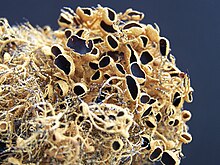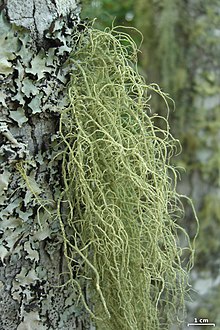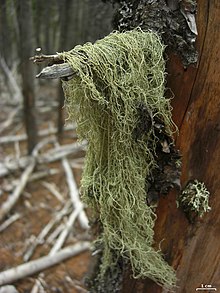Usnea
| Usnea | |
|---|---|

| |
| Scientific classification | |
| Kingdom: | Fungi |
| Division: | Ascomycota |
| Class: | Lecanoromycetes |
| Order: | Lecanorales |
| Family: | Parmeliaceae |
| Genus: | Usnea Dill. ex. Adans. (1763) |
| Type species | |
| Usnea florida (L.) F.H.Wigg. (1780)
| |
| Species | |
|
See text | |
Usnea is a genus of mostly pale grayish-green fruticose lichens that grow like leafless mini-shrubs or tassels anchored on bark or twigs.[1]: 203 The genus is in the family Parmeliaceae. It grows all over the world. Members of the genus are commonly called old man's beard, beard lichen, or beard moss.[1]: 203
Like other lichens it is a symbiosis of two or three fungi and an alga.[2] In Usnea, the fungus belongs to the division Ascomycota, while the alga is a member of the division Chlorophyta.
Members of the genus are similar to those of the genus Alectoria.[1]: 148 A distinguishing test is that the branches of Usnea are somewhat elastic, but the branches of Alectoria snap cleanly off.[1]: 148
Morphology and reproduction[]
As a fruticose lichen, Usnea appears as a shrub-like growth on host trees. Unlike other similar-looking fruticose lichens, species in this genus have an elastic chord or axis running through the middle of the thallus that can be revealed by gently pulling a filament apart from either end.[3] It reproduces via vegetative means through fragmentation, asexual means through soredia, or sexual means through and spermatogonium.[4] The growth rate of lichens in nature is slow, but the growth rate has been sped up in laboratory conditions where Usnea is being cultured.[5] Usnea looks very similar to the plant Spanish moss, so much so that the latter's Latin name is derived from it (Tillandsia usneoides, the 'Usnea-like Tillandsia').
Taxonomy[]
Many species have been described. A three-volume series by Józef Motyka published in 1936 and 1947 distinguished 451 species.[6] Many of these are now regarded as morphological varieties and adaptations to local circumstances. The taxonomic categorization of many members of this genus remains uncertain. The number of recognized species in Finland is decreasing for this reason, from 34 in 1951 to 25 in 1963 and only 12 in 2000.[7] It is now noted as including more than 600 species and being one of the largest genera within the Parmeliaceae.[8] The species Usnea longissima was renamed Dolichousnea longissima in 2004.[9]
Evolutionary history[]
Based on a fossil Usnea found in Baltic amber, it is known that the genus dates back to at least the late Eocene, about 34 million years ago. The elastic central cord that keeps the branch of the lichen intact even when its cortex is split is an adaptation that has helped allow the genus to thrive in many ecosystems and climates.[10]
Ecology[]
Like other lichens, Usnea often grows on sick or dying trees due to the pre-existing loss of canopy leaves, allowing for greater photosynthesis by the lichen's algae; this leads some gardeners to mistakenly blame the lichen for the tree's leaf loss and illness.[11]
Usnea is very sensitive to air pollution, especially sulfur dioxide.[12] Under poor growing conditions, such as areas high in pollution, they may grow no larger than a few millimetres, if they survive at all. Where the air is unpolluted, they can grow to 10–20 cm long. It can sometimes be used as a bioindicator, because it tends to only grow in those regions where the air is clean,[13] and of high quality.
Uses[]
Medical claims[]
According to Paul Bergner, Author of Medical Herbalism. "The usnic acid in Usnea is effective against gram positive bacteria such as Streptococcus and Staphylococcus, making Usnea a valuable addition to herbal formulas for sore throats and skin infections. It is also effective against a bacterium that commonly causes pneumonia"[14]
There is reason to believe that Usnea, in high concentrations, could possess some toxicity.[15] The National Toxicology Program is currently evaluating the issue.[16]
Dyes[]
Usnea species have been used to create orange, yellow, green, blue, and purple dyes for textiles.[17][18]
Cosmetics[]
Usnea barbata has been used in cosmetic production for its antimicrobial and antifungal properties as a preservative and deodorant.[19]
Combustible[]
Usnea barbata when dry is extremely flammable and is often used as a firestarter.
Species[]







- Stirt. (1898)
- G.N.Stevens (1999)
- (Müll.Arg.) Zahlbr. (1930)
- Ach. (1814)
- Du Rietz (1926)
- Truong & P.Clerc (2016)
- Usnea articulata (L.) Hoffm. (1796)
- A. Gerlach & P.Clerc (2017)
- Øvstedal (2012)
- Zahlbr. (1930)
- P.Clerc (2015)
- P.Clerc (2007)
- Tuck. (1850)
- P.Clerc (2007)
- Ach. (1810)
- Stirt. (1883)
- Motyka (1937)
- Truong (2016)
- Asahina (1956)
- Körb. (1859)
- Truong & P.Clerc (2013)
- Truong & P.Clerc (2011)
- P.Clerc (2011)
- Vain. (1925)
- G.N.Stevens (1999)
- Motyka (1936)
- G.N.Stevens (1991)
- P.Clerc (1992)
- J.M. Rodr. & P.Clerc (2011)
- Usnea filipendula Stirt. (1881)
- (Stirt.) Motyka (1936)
- Stirt. (1881)
- Räsänen (1936)
- Truong & P.Clerc (2012)
- A.Gerlach & P.Clerc (2017)
- Usnea florida (L.) Weber ex F.H.Wigg. (1780)
- C.W.Dodge (1948)
- Vain. (1928)
- Hav. ex Lynge (1921)
- Usnea fulvoreagens (Räsänen) Räsänen (1935)
- Truong & P.Clerc (2011)
- P.Clerc (2006)
- Usnea glabrata (Ach.) Vain. (1915)
- Usnea glabrescens (Nyl. ex Vain.) Vain. (1925)
- Motyka (1930)
- Truong & P.Clerc (2011)
- A.Gerlach & P.Clerc (2017)
- Stirt. (1883)
- Usnea hirta (L.) Weber ex F.H.Wigg. (1780)
- Motyka (1936)
- Usnea intermedia (A.Massal.) Jatta (1909)
- A.Gerlach & P.Clerc (2017)
- P.Clerc (2006)
- (Imshaug) Wirtz & Lumbsch (2011)
- Usnea lapponica Vain. (1925)
- Bungartz, Truong & Herrera-Camp. (2018)
- J.M.Rodr. & P.Clerc (2011)
- P.Clerc (2006)
- Stirt. (1882)
- (Vain.) Motyka (1937)
- Herrera-Camp., Bungartz, Truong & P.Clerc (2018)
- (Stirt.) G.Awasthi (1985)
- Wirtz & Lumbsch (2011)
- Stirt. (1883)
- P.Clerc (2007)
- Motyka (1936)
- Taylor (1847)
- Motyka (1937)
- G.N.Stevens (1999)
- Stirt. (1881)
- A.Gerlach & P.Clerc (2019)
- Halonen (2000)
- Wirtz & Lumbsch (2011)
- K.Mark, S.Will-Wolf & T.Randlane (2016)
- Bungartz, Herrera-Camp. & P.Clerc (2018)
- Motyka (1936)
- Stirt. (1881)
- (Asahina) P.Clerc (2004)
- C.W. Dodge (1948)
- Fr. (1846)
- Vain. (1909)
- (Asahina) Y. Ohmura (2011)
- Lendemer & I.I.Tav. (2003)
- G.N.Stevens & R.W.Rogers (1979)
- Vain. (1921)
- Usnea rubicunda Stirt. (1881)
- Truong & P.Clerc (2011)
- Truong & P.Clerc (2016)
- Stirt. (1881)
- Swinscow & Krog (1979)
- J.M.Rodr. & P.Clerc (2011)
- Usnea scabrata Nyl. (1875)
- Usnea scabrida Taylor (1844)
- Motyka (1930)
- G.N.Stevens (1999)
- Truong & P.Clerc (2016)
- (D.J.Galloway) F.J. Walker (1985)
- Truong, P.Clerc & Herrera-Camp. (2018)
- Stirt. (1881)
- Truong & P.Clerc (2011)
- (Motyka) Swinscow & Krog (1979)
- P.Clerc (2006)
- Truong & P.Clerc (2013)
- Stirt. (1882)
- Truong & P.Clerc (2015)
- A.Gerlach & P.Clerc (2017)
- P.Clerc (2011)
- Nyl. ex Motyka (1937)
- (Hepp) Motyka (1938)
- Usnea taylorii Hook.f. & Taylor (1844)
- (Müll.Arg.) Zahlbr. (1930)
- (Stirt.) Müll.Arg. (1889)
- (I.M.Lamb) Wirtz, Printzen & Lumbsch (2008)
- P.Clerc & Otte (2018)
- Mont. & Bosch (1856)
- Räsänen (1931)
- Nyl. (1876)
References[]
- ^ a b c d Field Guide to California Lichens, Stephen Sharnoff, Yale University Press, 2014, ISBN 978-0-300-19500-2
- ^ Tuovinen; Ekman; Thor; Spribille; Johannesson (2019). "Two Basidiomycete Fungi in the Cortex of Wolf Lichens". Current Biology. 29 (3): 476–483.e5. doi:10.1016/j.cub.2018.12.022. PMID 30661799. S2CID 58630799.
- ^ Brodo, Irwin M.; Sylvia Duran Sharnoff; Stephen Sharnoff; Canadian Museum of Nature (2001). Lichens of North America. Yale University Press. pp. 709–710. ISBN 9780300082494. Retrieved 6 December 2012.
- ^ Marand, Sajan (5 January 2010). "Usnea". A Text Book of Botany: Vol. III. Calicut University. pp. 87–90. Retrieved 6 December 2012.
- ^ "Optimization of Culture Conditions for Lichen Usnea ghattensis G. Awasthi to Increase Biomass and Antioxidant Metabolite Production". Food Technol. Biotechnol. 47 (1): 7–12. 2009. ISSN 1330-9862.
- ^ Motyka, Józef. Lichenum generis usnea.
- ^ Halonen, Pekka (2000). Studies on the lichen genus Usnea in East Fennoscandia and Pasific North America (PDF). Oulu, Finland: Oulu University Library. p. 13. ISBN 9514255232. ISSN 0355-3191. Retrieved 6 December 2012.
- ^ Wirtz, Nora; Printzen, Christian; Sancho, Leopoldo G.; Lumbsch, Thorsten H. (1 May 2006). "The phylogeny and classification of Neuropogon and Usnea (Parmeliaceae, Ascomycota) revisited". Taxon. 55 (2): 367–376. doi:10.2307/25065584. ISSN 0040-0262. JSTOR 25065584.
- ^ Articus, Kristina (November 2004). "Neuropogon and the phylogeny of Usnea s.l. (Parmeliaceae, Lichenized Ascomycetes)" (PDF). Taxon. 53 (4): 925–934. doi:10.2307/4135560. ISSN 0040-0262. JSTOR 4135560. Retrieved 5 December 2012.
- ^ Kaasalainen, Ulla; Rikkinen, Jouko; Schmidt, Alexander R. (2020). "Fossil Usnea and similar fruticose lichens from Palaeogene amber". The Lichenologist. 52 (4): 319–324. doi:10.1017/s0024282920000286.
- ^ Brodo, Irwin M.; Sylvia Duran Sharnoff; Stephen Sharnoff; Canadian Museum of Nature (2001). Lichens of North America. Yale University Press. pp. 57–58. ISBN 9780300082494. Retrieved 6 December 2012.
- ^ Batty, Lesley C.; Hallberg, Kevin B., eds. (2010). Ecology of Industrial Pollution. Ecological Reviews. Cambridge University Press. p. 49. ISBN 9780521514460. Retrieved 4 December 2012.
Usnea spp., at one time widespread and luxuriant, almost entirely disappeared from a major area of England and Wales covering at least 68 000 km² and at least 6 000 km² of lowland Scotland, mainly as a result of the increase in atmospheric pollution.
- ^ "Usnea Lichens". www.lichens.net. Retrieved 2018-04-06.
- ^ http://medherb.com/Therapeutics/Immune_-_Lymphatics_and_antibiotics.htm
- ^ Jellin, JM; Gregory P.; Batz F.; Hitchens, K.; et al. (2000). "USNEA". Pharmacist's Letter/Prescriber's Letter Natural Medicines Comprehensive Database (3rd ed.). Stockton, CA: Therapeutic Research Facility. pp. 1048–1049. ISBN 0967613647.
Adverse reactions are uncommon in appropriate amounts. Poisoning can be possible, although signs of poisoning have not yet been described.
- ^ "Testing Status: Usnea lichen 09063". Testing Status of Agents at NTP. National Toxicology Program. Retrieved 5 December 2012.
- ^ Bolton, Eileen M. (1991). Lichens for Vegetable Dying (2 ed.). Julia Bolton Holloway. p. 27. ISBN 9781566590013.
- ^ Casselman, Karen Diadick (2001). Lichen Dyes: The New Source Book. Courier Dover Publications. pp. 33–36. ISBN 9780486412313.
- ^ Ash, Michael; Irene Ash (2004). "Lichen (Usnea barbata) extract". Handbook of Preservatives. Synapse Info Resources. p. 437. ISBN 9781890595661. Retrieved 6 December 2012.
- Usnea
- Taxa described in 1763
- Lichens
- Lecanorales genera